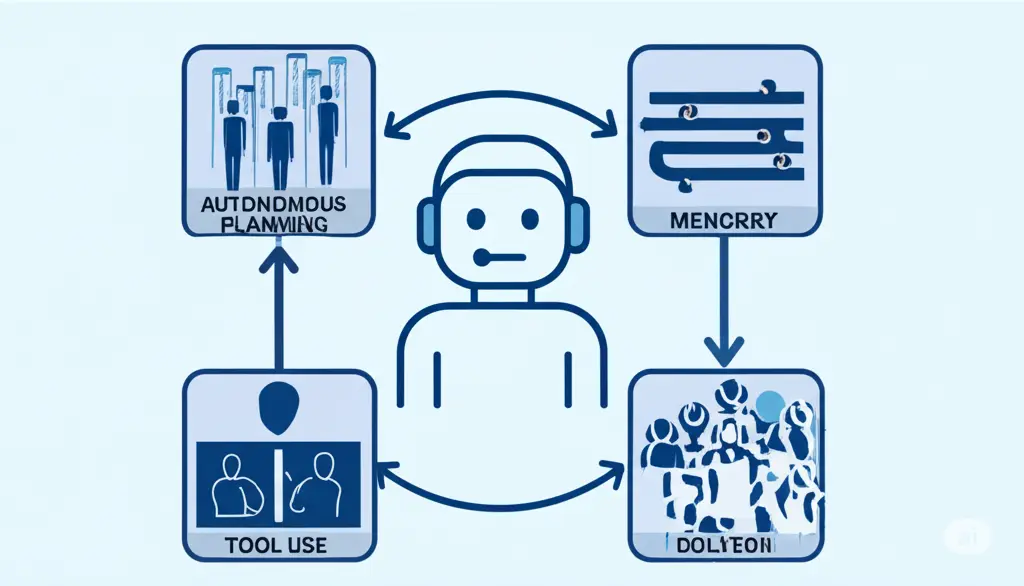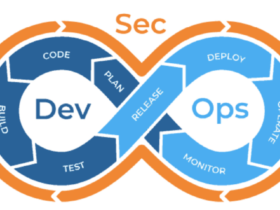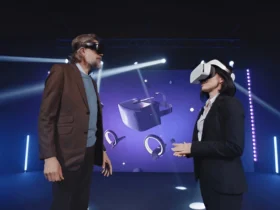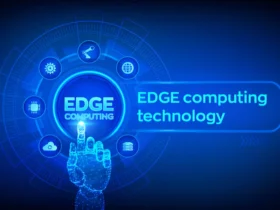The digital landscape is being profoundly reshaped by the rapid evolution of AI Agents and Autonomous Systems. These cutting-edge forms of artificial intelligence are moving beyond simple automation, capable of perceiving their environments, making independent decisions, and executing complex tasks with minimal human intervention. As of mid-2025, the conversation has shifted from theoretical concepts to practical, real-world deployments across diverse sectors, promising unprecedented levels of efficiency, innovation, and personalization. Understanding these powerful technologies is no longer just for tech enthusiasts; it’s essential for businesses and individuals navigating the future of work and daily life.
What are AI Agents and Autonomous Systems?
While often used interchangeably, it’s crucial to define what distinguishes AI Agents and Autonomous Systems from traditional AI or basic automation.
An AI Agent is an intelligent software system designed to autonomously perform specific tasks to achieve a defined goal. It acts on behalf of a user or another system, using AI to pursue objectives, complete multi-step tasks, and adapt its approach. Key characteristics of AI agents include:
- Perception: The ability to sense and interpret its environment (data, user input, sensor readings).
- Reasoning: The capacity to process information, make decisions, and plan actions.
- Action: The ability to execute tasks, interact with external tools, APIs, or physical environments.
- Learning: The capability to adapt and improve its performance over time based on feedback and new data.
- Goal-Oriented: Designed to work towards specific objectives without step-by-step human instructions.
Autonomous Systems, on the other hand, are broader and often refer to physical or digital systems that operate independently without continuous human oversight. While all autonomous systems may leverage AI, not all AI agents are full-fledged autonomous physical systems. Autonomous systems integrate AI agents (their “brains”) with physical components (like robots, vehicles) or complex software ecosystems to perform operations in dynamic environments. The defining trait is their self-sufficiency in operation and decision-making within defined parameters.
How AI Agents and Autonomous Systems Work
The operational framework of AI Agents and Autonomous Systems can be broken down into a continuous loop of perception, cognition, and action, often enhanced by learning.
- Sense (Perception) : The agent or system gathers data from its environment. This can involve:
- Digital Inputs : Processing user queries, analyzing system logs, integrating with APIs, or accessing databases.
- Physical Sensors : For autonomous vehicles or robots, this includes cameras, LiDAR, radar, microphones, and GPS to understand the physical world.
- Think (Cognition & Planning): Once data is collected, the AI agent analyzes it to determine the best course of action to achieve its goal. This involves:
- Data Processing: Extracting meaningful patterns from raw inputs using machine learning models (e.g., natural language processing for text, computer vision for images).
- Decision-Making: Evaluating inputs, reasoning through potential actions, and selecting the optimal path. This often involves complex algorithms, neural networks, and increasingly, large language models (LLMs) that facilitate sophisticated planning and problem decomposition.
- Memory & Context: Advanced agents maintain awareness of past interactions and outcomes, allowing them to adapt strategies and provide personalized responses.
- Act (Execution): Based on its analysis and plan, the agent takes action. This could be:
- Digital Actions: Generating a response, sending an email, adjusting system settings, initiating a workflow, or interacting with other software applications via “tool use.”
- Physical Actions: For autonomous systems, this involves controlling robotic arms, navigating a vehicle, or operating machinery.
- Feedback and Learning: The outcome of the action is observed, and this feedback is used to refine the agent’s models and decision-making processes, leading to continuous improvement and adaptation over time.
This iterative process, particularly the ability to plan dynamically and adapt, is what differentiates modern AI Agents and Autonomous Systems from simpler rule-based automation.
Distinguishing AI Agents from Autonomous Systems
While closely related, the terms “AI Agent” and “Autonomous System” have distinct nuances.
Think of it this way: an AI agent is the intelligent decision-maker, capable of planning and using tools. An autonomous system is the entire package—the agent plus the mechanisms (physical or digital) that allow it to operate and achieve its goals without constant human input. For instance, a self-driving car is an autonomous system, powered by multiple AI agents that handle perception, navigation, and decision-making.
Transformative Applications Across Industries
AI Agents and Autonomous Systems are no longer confined to research labs; their applications are rapidly expanding and redefining operational paradigms across numerous sectors.
These applications underscore how AI Agents and Autonomous Systems are moving beyond mere automation to create adaptive, intelligent solutions that enhance human capabilities and tackle complex challenges.
Benefits and Challenges of Advanced AI
The rise of AI Agents and Autonomous Systems brings a wave of transformative benefits, but also significant ethical, societal, and operational challenges that demand careful consideration and proactive management.
Key Benefits :
- Increased Efficiency and Automation: Automating repetitive, complex, or time-consuming tasks leads to significant operational cost reductions and higher productivity. AI agents can work 24/7 without fatigue.
- Enhanced Decision-Making: AI agents can analyze vast datasets rapidly, identifying patterns and insights that humans might miss, leading to more informed and accurate decisions.
- Improved Accuracy and Reduced Error: By removing human error from repetitive tasks and leveraging data-driven decision-making, AI systems can achieve higher levels of precision.
- Scalability: AI agents can scale operations quickly and efficiently to meet fluctuating demands without the limitations of human workforce capacity.
- Safety in Hazardous Environments: Autonomous robots can perform tasks in dangerous conditions (e.g., defusing bombs, exploring hazardous sites), protecting human lives.
- Personalization: AI agents can tailor experiences, recommendations, and services to individual user needs, enhancing customer satisfaction.
- New Discoveries and Innovations: Accelerating research and development in fields like drug discovery, material science, and climate modeling.
Significant Challenges:
- Ethical Concerns and Bias: AI agents learn from data, and if that data reflects societal biases, the AI can perpetuate or even amplify those biases, leading to unfair or discriminatory outcomes. Ensuring fairness, transparency, and accountability in AI decision-making is critical.
- Job Displacement: A major concern is the potential for widespread job displacement as AI agents and autonomous systems take over tasks traditionally performed by humans, not just in manual labor but increasingly in cognitive roles. This requires robust strategies for workforce retraining and adaptation.
- Privacy and Security Risks: Autonomous agents often require access to vast amounts of data, including sensitive personal or organizational information. This raises significant privacy concerns and increases the attack surface for cyber threats if not properly secured.
- Lack of Transparency (Black Box Problem): The complex nature of some AI models (especially deep learning) can make it difficult to understand why an AI agent made a particular decision, hindering debugging, auditing, and trust.
- Accountability and Control: Determining who is responsible when an autonomous system makes an error or causes harm is a complex legal and ethical challenge. Maintaining human oversight and control is essential.
- Operational Failures and Unintended Consequences: While AI is designed to reduce error, unforeseen circumstances or flaws in design can lead to catastrophic failures, especially in real-world autonomous systems (e.g., self-driving car accidents).
- Over-reliance and Deskilling: Over-dependence on AI agents can lead to a decline in human skills and critical thinking if not balanced with human involvement.
- Regulatory Lag: Technology is advancing faster than regulation, leading to a gap where legal and ethical frameworks struggle to keep pace with AI capabilities.
For a deeper understanding of the ethical considerations, you can refer to the Ethics of Autonomous AI Agents: Risks, Challenges, Tips from Auxiliobits.
The Future Landscape of AI Agents and Autonomous Systems
Looking ahead to the latter half of 2025 and beyond, the trajectory of AI Agents and Autonomous Systems points towards increased sophistication, specialization, and integration.
- Multi-Agent Systems (MAS): Expect to see more complex ecosystems where multiple specialized AI agents collaborate to achieve larger, more intricate goals. For example, a “research agent” gathers information, a “writing agent” drafts content, and an “editing agent” refines it, all orchestrated by a “management agent.” This hierarchical coordination will tackle problems too vast for a single agent.
- Vertical AI Agent Specialization: Generic AI assistants will give way to highly specialized agents designed for specific industries. We’re already seeing this in healthcare (clinical decision support agents), financial services (risk assessment agents), and retail (inventory management agents), delivering higher ROI due to their domain-specific knowledge.
- Enhanced Tool Use and Reasoning: Future agents will become even more adept at integrating with and leveraging external applications, databases, and real-time web data. Their planning algorithms will improve, handling longer time horizons, managing uncertainty, and optimizing resource allocation across complex dependencies.
- Self-Correction and Evaluation: Agents will increasingly incorporate sophisticated reflection mechanisms, allowing them to evaluate their own progress, identify failures, and adjust strategies autonomously to improve performance.
- Seamless Human-Agent Collaboration: The focus will be on creating more intuitive interfaces for humans to provide high-level direction, define constraints, and evaluate outcomes, while agents handle the intricate execution details. This partnership aims to free up human creativity and strategic thinking.
- Edge-Native AI Agents: The deployment of AI agents directly on devices (e.g., smartphones, IoT devices) will accelerate, leveraging efficient models like Google’s Gemma 3n. This enables real-time AI capabilities without constant cloud connectivity.
The future of AI Agents and Autonomous Systems is not just about isolated functionalities but about creating intelligent, adaptive, and interconnected layers of automation that will fundamentally change how businesses operate and how individuals interact with technology.
The emergence of AI Agents and Autonomous Systems marks a pivotal moment in the history of artificial intelligence. These technologies are transcending simple automation, offering unparalleled capabilities in problem-solving, decision-making, and task execution. From revolutionizing industries like healthcare and finance to transforming how we manage our cities and transportation, their impact is profound and far-reaching. While significant challenges related to ethics, safety, and societal adaptation remain, the continuous advancements in this field promise a future where intelligent systems work seamlessly alongside humans, augmenting our abilities and driving unprecedented levels of efficiency and innovation.
Curious to explore more about the cutting-edge of AI and its impact on the future? Dive deeper into our technology insights at jurnalin!










اترك رد